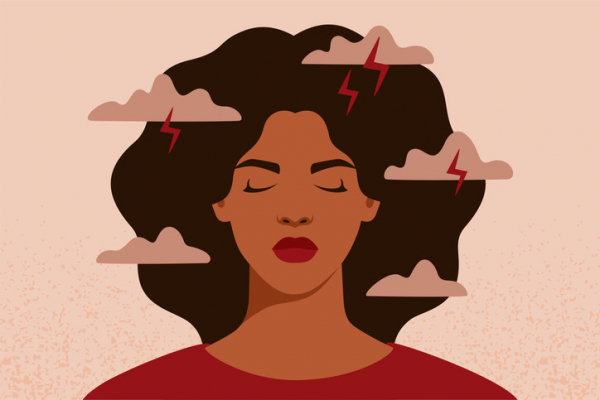
Gratitude enhances health, brings happiness — and may even lengthen lives

Several evenings a week, as Tyler VanderWeele gathers around the dinner table with his wife and two young kids, the family deliberately pauses during the meal to do something simple but profound. Each member shares several things for which they’re grateful — an act that VanderWeele, co-director of the Initiative on Health, Spirituality, and Religion at the Harvard T.H. Chan School of Public Health, feels changes his family dynamic for the better.
“I do think it makes a difference and can be a very powerful practice,” he says. “Even on those bad days where life seems difficult, that effort is worthwhile.”
Gratitude, health, and longevity
How can the power of gratitude affect our lives? Recent research has pointed to gratitude’s myriad positive health effects, including greater emotional and social well-being, better sleep quality, lower depression risks, and favorable markers of cardiovascular health. Now, new data from the long-term Nurses’ Health Study shows that it may extend lives.
“Gratitude has been one of the most widely studied activities contributing to well-being, but we couldn’t find a single prior study that looked at its effects on mortality and longevity, much to our surprise,” says VanderWeele, co-author of the new research.
What did the study look at?
Published July 2024 in JAMA Psychiatry, the new study drew on data from 49,275 women enrolled in the Nurses’ Health Study. Their average age was 79. In 2016, participants completed a six-item gratitude questionnaire in which they ranked their agreement with statements such as, “I have so much in life to be thankful for,” and “If I had to list everything I felt grateful for, it would be a very long list.”
Four years later, researchers combed through participants’ medical records to determine who had died. There were 4,608 deaths from all causes, as well as from specific causes such as cardiovascular disease, cancer, respiratory diseases, neurodegenerative disease, infection, and injury. Deaths from cardiovascular disease — a top killer of women and men in the United States — were the most common cause.
What did the researchers find?
Participants with gratitude scores in the highest third at the study’s start had a 9% lower risk of dying over the following four years than participants who scored in the bottom third. This did not change after controlling for physical health, economic circumstances, and other aspects of mental health and well-being. Gratitude seemed to help protect participants from every cause of death studied — including cardiovascular disease.
But what does this actually mean?
“A 9% reduction in mortality risk is meaningful, but not huge,” VanderWeele says. “But what’s remarkable about gratitude is that just about anyone can practice it. Anyone can recognize what’s around them and express thanks to others for what’s good in their life.”
While the study couldn’t pinpoint why gratitude is associated with longer life, VanderWeele believes several factors may contribute.
“We know that gratitude makes people feel happier. That in itself has a small effect on mortality risk,” he says. “Practicing gratitude may also make someone a bit more motivated to take care of their health. Maybe they’re more likely to show up for medical appointments or exercise. It may also help with relationships and social support, which we know contribute to health.”
What are the study’s limitations and strengths?
The study was observational. This means it can’t prove that gratitude helps people live longer — only that an association exists. And the particular sample of people analyzed is both the biggest strength and limitation of the research, VanderWeele says. All were older female nurses with high socioeconomic status. The vast majority were white.
“Does the longevity effect extend to men, to those who are younger, and to those with lower socioeconomic resources?” VanderWeele asks. “Those are all open questions.”
On the plus side, he says, the study sample’s large size is one of its biggest strengths. So is the extensive data gathered on potential confounding factors such as participants’ physical health, social characteristics, and other aspects of psychological well-being.
“Between the quality of the data and the size of the sample, we were able to provide reasonable evidence for this modest longevity effect,” he says.
Try this: Six questions to evoke gratitude
Not feeling especially grateful today? You have the power to change that. Asking yourself certain questions can evoke gratitude, such as
- What happened today that was good?
- What am I taking for granted that I can be thankful for?
- Which people in my life am I grateful for?
- What is the last book I read or movie, show, or social media clip I saw that I really appreciated, and why?
- What am I most looking forward to this week, month, and year, and why?
- What is the kindest thing someone has said or done lately?
Similarly, a few simple actions can infuse gratitude into your days. Try VanderWeele’s family routine of regularly expressing gratitude around the dinner table. Another well-known practice — that’s perhaps becoming forgotten in this digital age — is penning thank-you notes.
“I do think writing a thank-you note or gratitude letter gets your mind to dwell on something positive for a longer period, to think more deeply about it, because you have to put it not just in words, but in writing,” VanderWeele says. “It also deepens the relationship and builds that bond.”
One less-recognized but valuable gratitude practice is called a “savoring exercise,” which builds on aspects of mindfulness. All that’s required is “pausing, looking around you, and taking in and enjoying everything that’s good in your current setting,” VanderWeele says. “It’s not a big leap to go from recognizing the good to expressing gratitude for what you have.”
About the Author

Maureen Salamon, Executive Editor, Harvard Women's Health Watch
Maureen Salamon is executive editor of Harvard Women’s Health Watch. She began her career as a newspaper reporter and later covered health and medicine for a wide variety of websites, magazines, and hospitals. Her work has … See Full Bio View all posts by Maureen Salamon
About the Reviewer

Howard E. LeWine, MD, Chief Medical Editor, Harvard Health Publishing; Editorial Advisory Board Member, Harvard Health Publishing
Dr. Howard LeWine is a practicing internist at Brigham and Women’s Hospital in Boston, Chief Medical Editor at Harvard Health Publishing, and editor in chief of Harvard Men’s Health Watch. See Full Bio View all posts by Howard E. LeWine, MD

Do tattoos cause lymphoma?

Not so long ago, a friend texted me from a coffee shop. He said, "I can't believe it. I'm the only one here without a tattoo!" That might not seem surprising: a quick glance around practically anywhere people gather shows that tattoos are widely popular.
Nearly one-third of adults in the US have a tattoo, according to a Pew Research Center survey, including more than half of women ages 18 to 49. These numbers have increased dramatically over the last 20 years: around 21% of US adults in 2012 and 16% of adults in 2003 reported having at least one tattoo.
If you're among them, some recent headlines may have you worried:
Study Finds That Tattoos Can Increase Your Risk of Lymphoma (OnlyMyHealth)
Getting a Tattoo Puts You At Higher Risk of Cancer, Claims Study (NDTV)
Inky waters: Tattoos increase risk of lymphoma by over 20%, study says (Local12.com)
Shocking study reveals tattoos may increase risk of lymphoma by 20% (Fox News)
What study are they talking about? And how concerned should you be? Let's go through it together. One thing is clear: there's much more to this story than the headlines.
Why are researchers studying a possible link between tattoos and lymphoma?
Lymphoma is a type of cancer that starts in the lymphatic system, a network of vessels and lymph nodes that twines throughout the body. With about 90,000 newly diagnosed cases a year, lymphoma is one of the most common types of cancer.
Risk factors for it include:
- advancing age
- certain infections (such as Epstein-Barr virus, HIV, and hepatitis C)
- exposure to certain chemicals (such as benzene, or possibly pesticides)
- family history of lymphoma
- exposure to radiation (such as nuclear reactor accidents or after radiation therapy)
- having an impaired immune system
- certain immune diseases (such as rheumatoid arthritis, Sjogren's disease, or celiac disease).
Tattoos are not known to be a cause or risk factor for lymphoma. But there are several reasons to wonder if there might be a connection:
- Ink injected under the skin to create a tattoo contains several chemicals classified as carcinogenic (cancer causing).
- Pigment from tattoo ink can be found in enlarged lymph nodes within weeks of getting a tattoo.
- Immune cells in the skin can react to the chemicals in tattoo ink and travel to nearby lymph nodes, triggering a bodywide immune reaction.
- Other triggers of lymphoma, such as pesticides, have a similar effect on immune cells in lymph nodes.
Is there a connection between tattoos and lymphoma?
Any potential connection between tattoos and lymphoma has not been well studied. I could find only two published studies exploring the possibility, and neither found evidence of a compelling link.
The first study compared 737 people with the most common type of lymphoma (called non-Hodgkin's lymphoma) with otherwise similar people who did not have lymphoma. The researchers found no significant difference in the frequency of tattoos between the two groups.
A study published in May 2024 — the one that triggered the scary headlines above — was larger. It compared 1,398 people ages 20 to 60 who had lymphoma with 4,193 people who did not have lymphoma but who were otherwise similar. The study found that
- lymphoma was 21% more common among those with tattoos
- lymphoma risk varied depending on how much time had passed since getting the tattoo:
- within two years, lymphoma risk was 81% higher
- between three and 10 years, no definite increased lymphoma risk was detected
- 11 or more years after getting a tattoo, lymphoma risk was 19%
There was no correlation between the size or number of tattoos and lymphoma risk.
What else should you know about the study?
Importantly, nearly all of the differences in rates of lymphoma between people with and without tattoos were not statistically significant. That means the reported link between lymphoma and tattoos is questionable — and quite possibly observed by chance. In fact, some of the other findings argue against a connection, such as the lack of a link between size or number of tattoos and lymphoma risk.
In addition, if tattoos significantly increase a person's risk of developing lymphoma, we might expect lymphoma rates in the US to be rising along with the popularity of tattoos. Yet that's not the case.
Finally, a study like this one (called an association study) cannot prove that a potential trigger of disease (in this case, tattoos) actually caused the disease (lymphoma). There may be other factors (called confounders) that are more common among people who have tattoos, and those factors might account for the higher lymphoma risk.
Do tattoos come with other health risks?
While complication rates from reputable and appropriately certified tattooists are low, there are health risks associated with tattoos:
- infection, including bacterial skin infections or viral hepatitis
- allergic reactions to the ink
- scarring
- rarely, skin cancer (melanoma and other types of skin cancer).
The bottom line
Despite headlines suggesting a link between tattoos and the risk of lymphoma, there's no convincing evidence it's true. We'll need significantly more research to say much more than that. In the meantime, there are more important health concerns to worry about and much better ways for all of us to reduce cancer risk.
About the Author

Robert H. Shmerling, MD, Senior Faculty Editor, Harvard Health Publishing; Editorial Advisory Board Member, Harvard Health Publishing
Dr. Robert H. Shmerling is the former clinical chief of the division of rheumatology at Beth Israel Deaconess Medical Center (BIDMC), and is a current member of the corresponding faculty in medicine at Harvard Medical School. … See Full Bio View all posts by Robert H. Shmerling, MD

Which migraine medications are most helpful?

If you suffer from the throbbing, intense pain set off by migraine headaches, you may well wonder which medicines are most likely to offer relief. A recent study suggests a class of drugs called triptans are the most helpful option, with one particular drug rising to the top.
The study drew on real-world data gleaned from more than three million entries on My Migraine Buddy, a free smartphone app. The app lets users track their migraine attacks and rate the helpfulness of any medications they take.
Dr. Elizabeth Loder, professor of neurology at Harvard Medical School and chief of the Division of Headache at Brigham and Women’s Hospital, helped break down what the researchers looked at and learned that could benefit anyone with migraines.
What did the migraine study look at?
Published in the journal Neurology, the study included self-reported data from about 278,000 people (mostly women) over a six-year period that ended in July 2020. Using the app, participants rated migraine treatments they used as “helpful,” “somewhat helpful,” or “unhelpful.”
The researchers looked at 25 medications from seven drug classes to see which were most helpful for easing migraines. After triptans, the next most helpful drug classes were ergots such as dihydroergotamine (Migranal, Trudhesa) and anti-emetics such as promethazine (Phenergan). The latter help ease nausea, another common migraine symptom.
“I’m always happy to see studies conducted in a real-world setting, and this one is very clever,” says Dr. Loder. The results validate current guideline recommendations for treating migraines, which rank triptans as a first-line choice. “If you had asked me to sit down and make a list of the most helpful migraine medications, it would be very similar to what this study found,” she says.
What else did the study show about migraine pain relievers?
Ibuprofen, an over-the-counter pain reliever sold as Advil and Motrin, was the most frequently used medication in the study. But participants rated it “helpful” only 42% of the time. Only acetaminophen (Tylenol) was less helpful, helping just 37% of the time. A common combination medication containing aspirin, acetaminophen, and caffeine (sold under the brand name Excedrin) worked only slightly better than ibuprofen, or about half the time.
When researchers compared helpfulness of other drugs to ibuprofen, they found:
- Triptans scored five to six times more helpful than ibuprofen. The highest ranked drug, eletriptan, helped 78% of the time. Other triptans, including zolmitriptan (Zomig) and sumatriptan (Imitrex), were helpful 74% and 72% of the time, respectively. In practice, notes Dr. Loder, eletriptan seems to be just a tad better than the other triptans.
- Ergots were rated as three times more helpful than ibuprofen.
- Anti-emetics were 2.5 times as helpful as ibuprofen.
Do people take more than one medicine to ease migraine symptoms?
In this study, two-thirds of migraine attacks were treated with just one drug. About a quarter of the study participants used two drugs, and a smaller number used three or more drugs.
However, researchers weren’t able to tease out the sequence of when people took the drugs. And with anti-nausea drugs, it’s not clear if people were rating their helpfulness on nausea rather than headache, Dr. Loder points out. But it’s a good reminder that for many people who have migraines, nausea and vomiting are a big problem. When that’s the case, different drug formulations can help.
Are pills the only option for migraine relief?
No. For the headache, people can use a nasal spray or injectable version of a triptan rather than pills. Pre-filled syringes, which are injected into the thigh, stomach, or upper arm, are underused among people who have very rapid-onset migraines, says Dr. Loder. “For these people, injectable triptans are a game changer because pills don’t work as fast and might not stay down,” she says.
For nausea, the anti-emetic ondansetron (Zofran) is very effective, but one of the side effects is headache. You’re better off using promethazine or prochlorperazine (Compazine), both of which treat nausea but also help ease headache pain, says Dr. Loder.
Additionally, many anti-nausea drugs are available as rectal suppositories. This is especially helpful for people who have “crash” migraines, which often cause people to wake up vomiting with a migraine, she adds.
What are the limitations of this migraine study?
The data didn’t include information about the timing, sequence, formulation, or dosage of the medications. It also omitted two classes of newer migraine medications — known as gepants and ditans — because there was only limited data on them at the time of the study. These options include
- atogepant (Qulipta) and rimegepant (Nurtec)
- lasmiditan (Reyvow).
“But based on my clinical experience, I don’t think that any of these drugs would do a lot better than the triptans,” says Dr. Loder.
Another shortcoming is the study population: a selected group of people who are able and motivated to use a migraine smartphone app. That suggests their headaches are probably worse than the average person, but that’s exactly the population for whom this information is needed, says Dr. Loder.
“Migraines are most common in young, healthy people who are trying to work and raise children,” she says. It’s good to know that people using this app rate triptans highly, because from a medical point of view, these drugs are well tolerated and have few side effects, she adds.
Are there other helpful takeaways?
Yes. In the study, nearly half the participants said their pain wasn’t adequately treated. A third reported using more than one medicine to manage their migraines.
If you experience these problems, consult a health care provider who can help you find a more effective therapy. “If you’re using over-the-counter drugs, consider trying a prescription triptan,” Dr. Loder says. If nausea and vomiting are a problem for you, be sure to have an anti-nausea drug on hand.
She also recommends using the Migraine Buddy app or the Canadian Migraine Tracker app (both are free), which many of her patients find helpful for tracking their headaches and triggers.
About the Author

Julie Corliss, Executive Editor, Harvard Heart Letter
Julie Corliss is the executive editor of the Harvard Heart Letter. Before working at Harvard, she was a medical writer and editor at HealthNews, a consumer newsletter affiliated with The New England Journal of Medicine. She … See Full Bio View all posts by Julie Corliss
About the Reviewer

Howard E. LeWine, MD, Chief Medical Editor, Harvard Health Publishing; Editorial Advisory Board Member, Harvard Health Publishing
Dr. Howard LeWine is a practicing internist at Brigham and Women’s Hospital in Boston, Chief Medical Editor at Harvard Health Publishing, and editor in chief of Harvard Men’s Health Watch. See Full Bio View all posts by Howard E. LeWine, MD